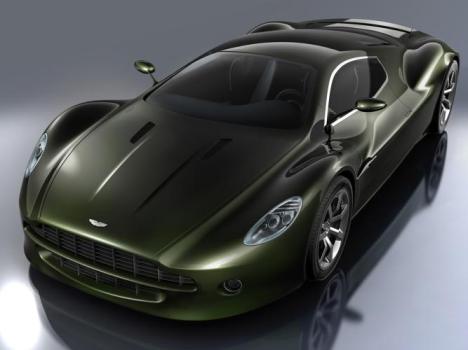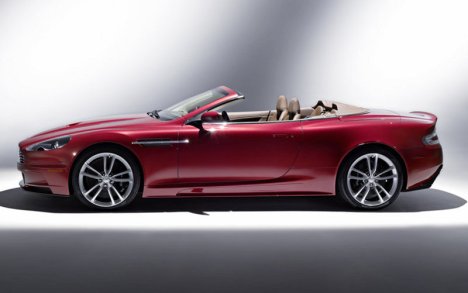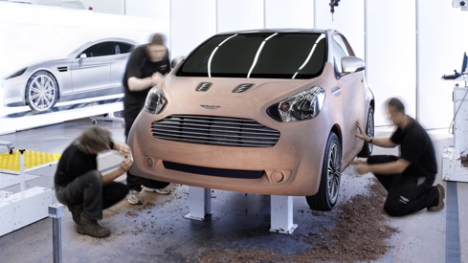
I’m on the phone with Automobile Magazine’s road test editor and all-around Anglophile, Marc Noordeloos, discussing the gorgeous Aston Martin DB9 sitting in my driveway. From the background, his British (and very fabulous) mother-in-law yells that the DB9 is nothing more than an English Camaro.
So I wonder: if I had a Camaro in my possession right now instead of the DB9, what would I do with it? I’d probably take it drag racing. It just so happens that Infineon Raceway, a quick drive from my house, hosts a quarter-mile drag race most Wednesday nights. And it just so happens that it’s Wednesday.
I had just admitted to Marc that the DB9 felt slow. He laughed at me and reminded me that the DB9 was capable of a 0-to-60-mph run in the mid-four-second range and a quarter-mile somewhere around 13 seconds at 110 mph. So either something is wrong with this particular DB9, or something is wrong with me, was the implication. I assume it’s the latter, but I head off to the dragstrip to prove my insanity.
This being the first time I’ve ever run a car down a quarter-mile track, I had no idea what I was doing. My social anxiety was compounded by the fact that everyone was staring at me, the dude in the only $200,000 car on the grid. To my surprise, there were no insults thrown my way-at least none that I heard. People actually were nice-especially a couple in their sixties in their full-size pickup next to me on the grid. They walked over to me to offer the services of their son’s company, Central Coast Clear Bra, to protect my lovely new Aston from rock chips. By the time I explained the car wasn’t mine, they had also figured out that I was a drag strip virgin. So had the official, who was trying frantically to get my attention. Apparently I needed to do something called a qualifying run.
So I pull the big DB9 up to the lights, which gradually turn green, and I’m off. No wheelspin, no drama. The helmet seems so unnecessary, I think, as I keep my foot down with the automatic transmission orchestrating supple shift after supple shift. This is so unbelievably easy. And the Aston’s V-12, which sounds like not much of anything from inside the cabin, must have been doing a whole lot of something under the hood, because it hurtled the 4000-pound DB9 down the quarter-mile track in 12.851 seconds at 111.85 mph.
Yikes. There’s definitely nothing wrong with the Aston; I had just gotten more proof that I’m out of my mind. This is an observation that the officials share with me after they notice me hauling ass down the return road. Apparently I was slightly over (like, um, quadruple) the 15-mph speed limit. Which, in my defense, isn’t posted anywhere.
When I got back to the staging grid, my mentors in the F-150 explained some of the intricacies of bracket racing, wrote a number on my windshield, and sent me on my way. The rest of the evening was uneventful-I ran twice before I was eliminated. Both runs were within a hair of 13.0 seconds @ 111 mph.
But one thing is certain: the Aston is definitely not slow. I didn’t do a thorough check, but I didn’t see anything in the street class that was remotely close to the Aston’s thirteen-second achievement.
No, I realize later, the reason the Aston feels so slow is because I had just driven a brand-new 2009 Chevy Corvette ZR1 a few days earlier. I’m apparently ruined for life. If a 5.9-liter, 470-hp Aston Martin V-12 sounds unimpressive and feels slow, I fear I may never recover. Nothing on this planet can compare to the acoustic fury generated by the ZR1, not to mention its accelerative thrust.
I hereby sentence myself to driving nothing but mid-1980s four-cylinder Mercedes-Benz diesels until my sense of “fast” is restored. A 240D automatic should do. I think they did the quarter-mile in about three minutes, maybe four. What a drag.
I’m on the phone with Automobile Magazine’s road test editor and all-around Anglophile, Marc Noordeloos, discussing the gorgeous Aston Martin DB9 sitting in my driveway. From the background, his British (and very fabulous) mother-in-law yells that the DB9 is nothing more than an English Camaro.
So I wonder: if I had a Camaro in my possession right now instead of the DB9, what would I do with it? I’d probably take it drag racing. It just so happens that Infineon Raceway, a quick drive from my house, hosts a quarter-mile drag race most Wednesday nights. And it just so happens that it’s Wednesday.
I had just admitted to Marc that the DB9 felt slow. He laughed at me and reminded me that the DB9 was capable of a 0-to-60-mph run in the mid-four-second range and a quarter-mile somewhere around 13 seconds at 110 mph. So either something is wrong with this particular DB9, or something is wrong with me, was the implication. I assume it’s the latter, but I head off to the dragstrip to prove my insanity.
This being the first time I’ve ever run a car down a quarter-mile track, I had no idea what I was doing. My social anxiety was compounded by the fact that everyone was staring at me, the dude in the only $200,000 car on the grid. To my surprise, there were no insults thrown my way-at least none that I heard. People actually were nice-especially a couple in their sixties in their full-size pickup next to me on the grid. They walked over to me to offer the services of their son’s company, Central Coast Clear Bra, to protect my lovely new Aston from rock chips. By the time I explained the car wasn’t mine, they had also figured out that I was a drag strip virgin. So had the official, who was trying frantically to get my attention. Apparently I needed to do something called a qualifying run.
So I pull the big DB9 up to the lights, which gradually turn green, and I’m off. No wheelspin, no drama. The helmet seems so unnecessary, I think, as I keep my foot down with the automatic transmission orchestrating supple shift after supple shift. This is so unbelievably easy. And the Aston’s V-12, which sounds like not much of anything from inside the cabin, must have been doing a whole lot of something under the hood, because it hurtled the 4000-pound DB9 down the quarter-mile track in 12.851 seconds at 111.85 mph.
Yikes. There’s definitely nothing wrong with the Aston; I had just gotten more proof that I’m out of my mind. This is an observation that the officials share with me after they notice me hauling ass down the return road. Apparently I was slightly over (like, um, quadruple) the 15-mph speed limit. Which, in my defense, isn’t posted anywhere.
When I got back to the staging grid, my mentors in the F-150 explained some of the intricacies of bracket racing, wrote a number on my windshield, and sent me on my way. The rest of the evening was uneventful-I ran twice before I was eliminated. Both runs were within a hair of 13.0 seconds @ 111 mph.
But one thing is certain: the Aston is definitely not slow. I didn’t do a thorough check, but I didn’t see anything in the street class that was remotely close to the Aston’s thirteen-second achievement.
No, I realize later, the reason the Aston feels so slow is because I had just driven a brand-new 2009 Chevy Corvette ZR1 a few days earlier. I’m apparently ruined for life. If a 5.9-liter, 470-hp Aston Martin V-12 sounds unimpressive and feels slow, I fear I may never recover. Nothing on this planet can compare to the acoustic fury generated by the ZR1, not to mention its accelerative thrust.
I hereby sentence myself to driving nothing but mid-1980s four-cylinder Mercedes-Benz diesels until my sense of “fast” is restored. A 240D automatic should do. I think they did the quarter-mile in about three minutes, maybe four. What a drag.
Filed under: Aston Martin | Tagged: Aston Martin DB9 | Leave a comment »
 It is said that Mercedes will take Aston Martin and a future Aston Martin super car may appear within some years.
It is said that Mercedes will take Aston Martin and a future Aston Martin super car may appear within some years.











 The Aston Martin Lagonda Concept that appeared at Geneva Motor Show this year is unlikely to morph into a production car, according to reports.
The Aston Martin Lagonda Concept that appeared at Geneva Motor Show this year is unlikely to morph into a production car, according to reports. Aston Martin has announced a new compact car concept, the Cygnet. Aston calls the car a “luxury commuter concept,” but that wasn’t the biggest surprise in the news release.
Aston Martin has announced a new compact car concept, the Cygnet. Aston calls the car a “luxury commuter concept,” but that wasn’t the biggest surprise in the news release. The cool, calm, glamourous exterior of the Aston Martin DBS hides a bit of a secret.
The cool, calm, glamourous exterior of the Aston Martin DBS hides a bit of a secret.


 Imagine Motorhead releasing an album of choral music. Got it? Right. Now imagine an Aston Martin for £20,000 that’s actually based on the Toyota iQ city car.
Imagine Motorhead releasing an album of choral music. Got it? Right. Now imagine an Aston Martin for £20,000 that’s actually based on the Toyota iQ city car.